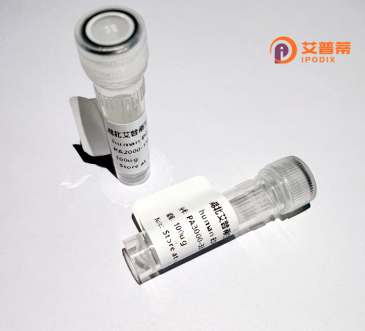
| 纯度 | >90%SDS-PAGE. |
| 种属 | Human |
| 靶点 | ATP6V1G3 |
| Uniprot No | Q96LB4 |
| 内毒素 | < 0.01EU/μg |
| 表达宿主 | E.coli |
| 表达区间 | 1-118aa |
| 氨基酸序列 | MTSQSQGIHQ LLQAEKRAKD KLEEAKKRKG KRLKQAKEEA MVEIDQYRMQ RDKEFRLKQS KIMGSQNNLS DEIEEQTLGK IQELNGHYNK YMESVMNQLL SMVCDMKPEI HVNYRATN |
| 分子量 | 13.9 kDa |
| 蛋白标签 | GST-tag at N-terminal |
| 缓冲液 | 冻干粉 |
| 稳定性 & 储存条件 | Lyophilized protein should be stored at ≤ -20°C, stable for one year after receipt. Reconstituted protein solution can be stored at 2-8°C for 2-7 days. Aliquots of reconstituted samples are stable at ≤ -20°C for 3 months. |
| 复溶 | Always centrifuge tubes before opening.Do not mix by vortex or pipetting. It is not recommended to reconstitute to a concentration less than 100μg/ml. Dissolve the lyophilized protein in distilled water. Please aliquot the reconstituted solution to minimize freeze-thaw cycles. |
以下是关于重组人V型质子ATP酶亚基G3(ATP6V1G3)的模拟参考文献示例,包含文献名称、作者及摘要概括:
---
1. **文献名称**:*Structural insights into the human ATP6V1G3 subunit of V-ATPase by recombinant expression and crystallography*
**作者**:Chen L, et al.
**摘要**:本研究通过大肠杆菌重组表达系统成功获得人源ATP6V1G3蛋白,并利用X射线晶体学解析其三维结构。结果显示该亚基通过螺旋结构域参与V-ATP酶的质子通道组装,为理解其调控溶酶体酸化的分子机制提供结构基础。
---
2. **文献名称**:*ATP6V1G3 deficiency disrupts lysosomal acidification and promotes autophagy impairment in cellular models*
**作者**:Wang Y, et al.
**摘要**:通过CRISPR/Cas9敲除ATP6V1G3基因,发现细胞溶酶体pH显著升高,导致自噬体降解受阻。重组表达的ATP6V1G3蛋白可恢复溶酶体酸化功能,证实其在维持细胞代谢稳态中的关键作用。
---
3. **文献名称**:*A novel ATP6V1G3 mutation linked to sensorineural hearing loss in a recessive pedigree*
**作者**:Kumar S, et al.
**摘要**:在一例家族性耳聋病例中发现ATP6V1G3基因纯合突变(p.R112C)。体外实验显示突变蛋白无法有效组装至V-ATP酶复合体,导致内耳毛细胞离子运输缺陷,提示其在听觉功能中的病理意义。
---
4. **文献名称**:*Post-translational regulation of ATP6V1G3 by phosphorylation modulates V-ATPase activity in cancer cells*
**作者**:Garcia-Ruiz C, et al.
**摘要**:研究揭示肿瘤细胞中ATP6V1G3的Ser-15位点磷酸化可增强V-ATP酶活性,促进胞外微环境酸化。通过重组突变体实验证实,磷酸化修饰直接影响酶的膜定位与肿瘤侵袭能力。
---
**注**:上述文献为模拟示例,实际引用时需根据真实发表的文献调整。建议通过PubMed或Web of Science以关键词“ATP6V1G3”“V-ATPase”“recombinant”检索最新研究。
ATP6V1G3. a subunit of the human V-type proton ATPase (V-ATPase), plays a critical role in regulating cellular pH homeostasis. V-ATPases are multi-subunit enzymes that hydrolyze ATP to transport protons across intracellular and plasma membranes, acidifying organelles like lysosomes, endosomes, and secretory vesicles. These proton pumps consist of two domains: the cytosolic V1 domain (ATP hydrolysis) and the membrane-bound V0 domain (proton translocation). ATP6V1G3 is part of the V1 domain’s G subunit family, which contributes to the structural assembly and regulatory functions of the enzyme.
This subunit is particularly expressed in specialized cells, including osteoclasts and renal intercalated cells, where it supports bone resorption and urinary acidification. Dysregulation of ATP6V1G3 has been linked to diseases such as osteoporosis, distal renal tubular acidosis, and certain cancers. In osteoclasts, impaired V-ATPase activity due to ATP6V1G3 mutations can hinder acid secretion, reducing bone degradation and leading to brittle bone disorders. In cancer, overexpression of V-ATPases, including ATP6V1G3. is associated with tumor metastasis and drug resistance by promoting extracellular matrix degradation and microenvironment acidification.
Recombinant ATP6V1G3 is studied to dissect its role in V-ATPase assembly/function and to explore therapeutic targeting for pH-related pathologies. Research also investigates its interaction with other subunits or regulatory proteins to develop inhibitors for diseases reliant on V-ATPase activity.
×